What is a Biotech Company and What Does it Do?
Biotechnology has been shaping our development since early civilization. But what is Biotechnology, and what does a biotech company do? In this article, we’ll explore these questions in detail.
Biotechnology companies, often referred to as biotech companies, exploit cellular and biomolecular processes to develop products and technologies that improve our lives and the health of our planet.
The term “biotechnology” was first penned by Karl Erkey, a Hungarian engineer, in 1919. However, the practice of biotechnology has a history almost as long as civilization itself.
What does a biotech company do?
Typically, biotech companies produce medicines. However, many of the biggest organizations also extend their services to industries including:
- Agriculture
- Plant & animal breeding
- Industrial technology
- Environmental science
- Forensic investigations
Companies in this field have an extensive understanding of the inner workings of DNA and biological functions; particularly how organisms interact and react to one another, how DNA structures form and develop in their early stages, and how these processes can be used to benefit humans.
Exploiting biological matter at a microscopic level may sound like the product of modern science, but humans have been using these methods for thousands of years — without really understanding what they were doing.
An example of this is the production of alcohol, in which yeast is added to barley and water to create beer.
Let’s break down this method and examine the biological processes that take place at each step.
1. Water and barley are combined and mashed together to create a sugary liquid called a ‘wort.’
Barley contains trace amounts of sugar, around 0.8g. When added to water and mashed together, the sugar is released to create a wort.
2. Yeast is added to the mixture, which reacts with the sugars in the wort to create alcohol.
Yeast are single celled organisms of the fungi family that eat sugar as they come into contact with it. The byproduct of this metabolic process creates waste products in the form of alcohol and carbon dioxide, both of which are required to make beer.
Currently there is no known way to turn sugar into alcohol without the use of yeast.
3. Hops, the flower of the Humulus lupulus plant, are then added to give the beer its primary taste. They also impart their antibacterial properties to the beer during the fermentation process.
Hops contain high concentrations of alpha and beta acids, which impede the growth of gram-positive bacteria. In this example, there are at least 3 notable biological processes taking place as a result of human interference. Another example is animal breeding, where subjects are selected based on desirable genetic traits to reproduce and pass down the parental traits to their offspring.
These principles are what form the basis of biotechnology. Organisms are combined together, altered, or are added to in order to encourage change that would otherwise not occur in the wild.
The byproducts of these processes, usually bacteria or enzymes, are generally what biotechnology companies are aiming to extract. These byproducts are then repurposed for use in medicine, plant food, pesticides, biofuel, etc.
What was the world’s first biotech company?
Genentech, founded in 1976, is considered the world’s first biotech company.
The company has made major innovations in the world of biotechnology since its inception, most notably in 1977 after successfully producing the hormone somatostatin; and in 1982, with the successful synthesis of human insulin — known as Humulin.
What’s the world’s largest biotech company?
Johnson & Johnson, founded in 1885, is the world’s largest biotechnology company.
Initially formed to develop and distribute ready-to-use sterile surgical supplies, wound dressings, household products and medical guides, the company has evolved into a multinational corporation, and one of the world’s most valuable companies.
Johnson & Johnson’s patent portfolio is global, containing more than 200,000 patents (including subsidiaries). The company’s patents are valued well beyond the industry average, as illustrated below.
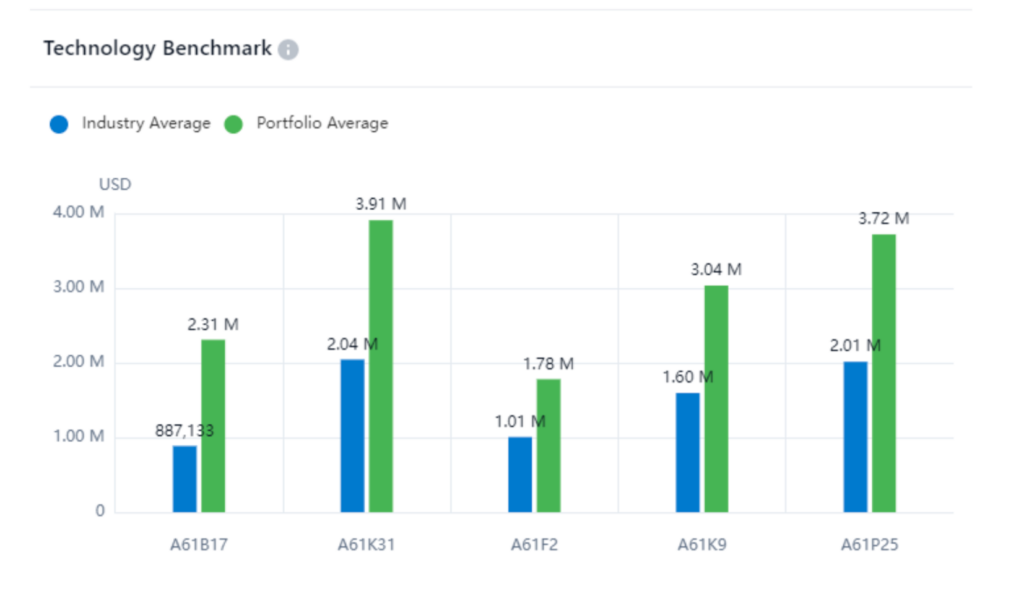
As of 2022 Johnson & Johnson is one of only two companies with a AAA prime credit rating — higher than that of the US government.
What’s the difference between biotechnical and pharmaceutical?
Both biotechnical and pharmaceutical companies produce medicines.
However, biotech companies develop their products from living organisms, while pharmaceuticals use chemical processes to synthesize the product they need.
The biggest example of a biotech product would be Humira, a monoclonal antibody that is used to treat a range of illnesses from rheumatoid arthritis to Crohn’s disease.
Currently, Humira is being explored and trialed for other indications, as illustrated below.
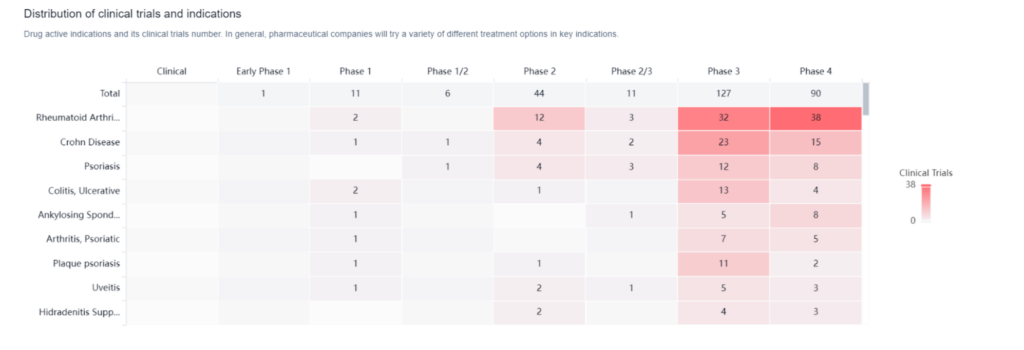
Humira, also known as Adalimumab, was developed with the use of phage display — the study of protein and DNA interactions with the use of bacteriophages (viruses that infect bacteria).
What are the types of biotechnology?
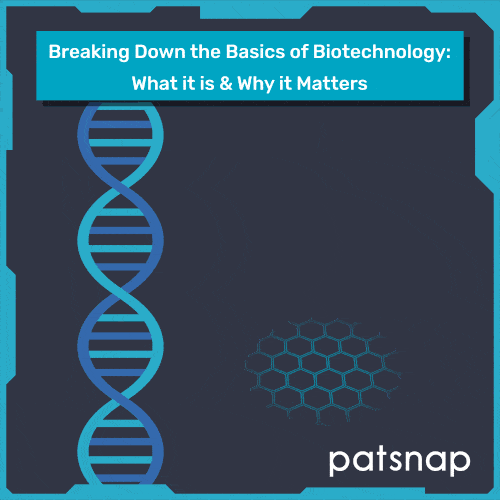
1. Medical
Medical biotechnology refers to the practice of using living cells and material to research and produce medicines, vaccines, treatments, etc.
It can also help us to understand the way certain medical conditions develop and adapt within a living organism, for instance, the way that cancer cells multiply.
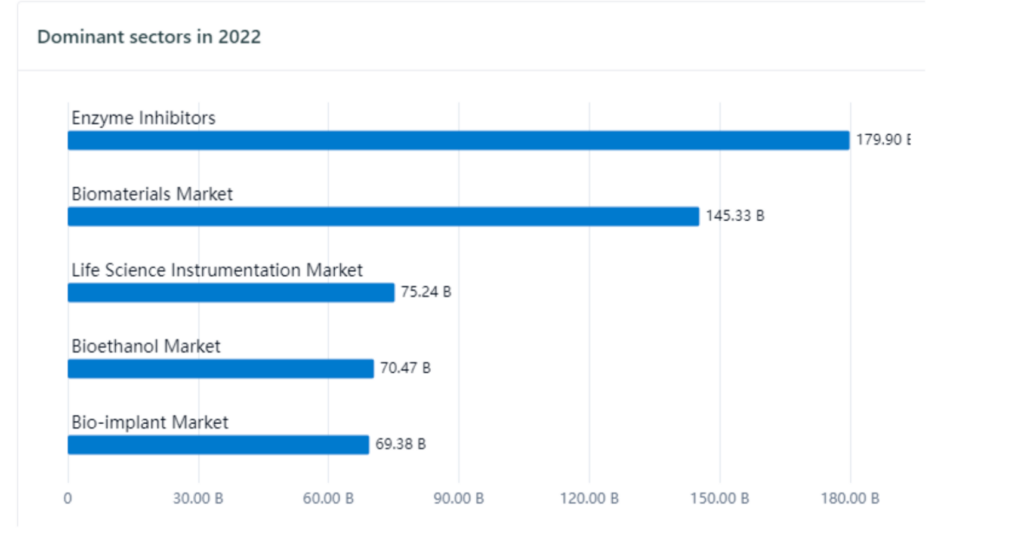
Within the healthcare field, some of the most dominant biotechnology sectors are highlighted above. Enzyme inhibitors, which are molecules that bind to an enzyme and block its activity (like Aspirin), currently sit in the number one position.
2. Agriculture
Agricultural biotechnology usually concerns the science of crop or livestock modification, such as genetically engineering or cross-breeding crops to increase their yield, flavor markers, visual characteristics, or lifespan.
Many crops are modified by introducing radiation to create a mutation within the crop. DNA mutations can occur randomly in all living organisms, but their effects cannot always be predicted.
During crop mutation, hundreds (sometimes thousands) of crops undergo genetic transformations to produce random effects. The progeny of these mutations is then selected based on desirable traits and pollinated to enforce this genetic change.
3. Animal breeding
Animal breeding is the oldest known example of biotechnology. The principles of breeding are relatively simple, yet it took humans thousands of years of practice to truly understand what was happening during this process.
A typical example is the breeding of guard dogs, which was likely the first reason humans explored biotechnology.
The desirable characteristics of a guard dog are:
- Size
- Temperament
- Obedience
- Overall health
In order to foster these qualities in subsequent generations, humans would breed two dogs with these desirable traits to enhance the offspring. This breeding process not only maintained desirable traits, but it also improved future generations via evolution.
The nuances of this process weren’t fully realized until the 20th century. Regardless, the tangible effects of breeding allowed humans to benefit from this incredible mechanic of nature, without fully understanding it.
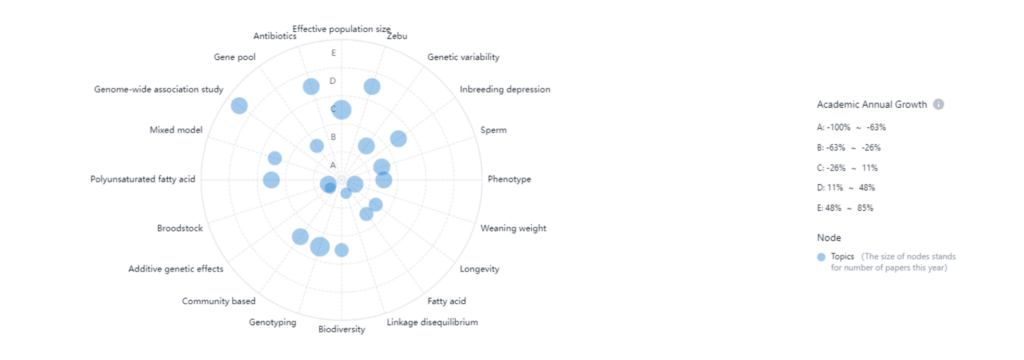
Emerging topics in the animal breeding sector are displayed above. Those with the highest compound annual growth rate (CAGR) such as genome-wide associations and antibiotics and Zebu, may be the most promising technologies. Those with the most papers, as indicated by node size, (effective population size and genotyping) are currently the most popular research topics in this technology space.
4. Industrial biotechnology
This discipline refers to the application of biotech to aid in developing systems and materials for industrial use. For instance, the creation of biofuels or bioplastics to replace currently unsustainable materials currently in use.
5. Environmental science
Biotechnology can be applied to environmental sciences to dramatically reduce the harmful effects of waste disposal on the planet. The principal life cycle of microorganisms is exactly the same as any other organism: Ingest nutrients, excrete waste.
In many cases, the nutrients that one subject ingests are the waste products of another organism. For example, trees consume carbon dioxide as their nutrients, which is then turned into oxygen as a waste product; which in turn is ingested by humans who expel carbon dioxide as their waste product.
All biological entities follow this cycle, what differs between them are the types of nutrients they eat, and the resulting waste product from those nutrients. Certain bacteria can digest the chemical components of our waste products, and in turn create waste products that are either harmless or can be used further by the biotechnology industry.
In this sense, we can use biotechnology to break down our waste products in a way that is not harmful to the earth and offers a better solution than burning or burying our waste.
Summary
Biotechnology is a phenomenon that continues to shape the future of human civilization, just as it has since the beginning of time. Its applications are wide and varied and have a profound effect on all aspects of our lives.
From the humble origins of beer brewing, where biotechnology is used to encourage new and exciting flavors of alcohol to advancements in cancer medicines where treatment can be personalized to a patients’ genetic information for more effective care.
Biotechnology provides us with continuous advancements, paving the way toward a more sustainable future.